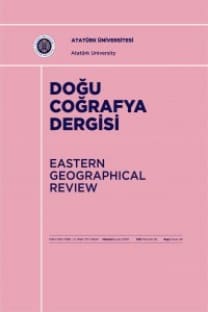BEYİN FIRTINASI TEKNİĞİNİN COĞRAFİ KAVRAMLARIN ÖĞRETİMİ VE KALICILIĞI ÜZERİNDEKİ ROLÜ (Erzurum Örneği) The Effect of Brainstorming Technique on Instructing Geographical Concepts (Erzurum Sample)
ÖZET Bu araştırmanın amacı, Beyin Fırtınası tekniğinin coğrafi kavramların öğretimi ve kalıcılığı üzerindeki etkilerini tespit etmektir. Araştırmada öntest-sontest kontrol gruplu deneysel desen kullanılmıştır. Araştırmanın örneklemi, Erzurum’daki bir lisenin iki şubesinde öğretime devam eden öğrencilerden oluşturulmuştur. 10. sınıflardan seçilen iki şube üzerinde yapılan bu araştırmada, toplam 60 öğrenci ile çalışılmıştır. Araştırmaya dahil edilen şubelerden biri deney diğeri kontrol grubu olarak seçilmiştir. Deney grubunda “Yeryüzünde Nüfus ve Nüfusun Nitelikleri” konusu Beyin Fırtınası öğretim tekniği kullanılarak işlenirken, kontrol grubunda ise konu geleneksel öğretim yöntemleri ile işlenmiştir. Araştırmanın verilerini toplamak amacıyla, her iki gruba da ön test, son test ve kalıcılık testi uygulanmıştır. Deney ve kontrol grubu öğrencilerinin ön test, son test ve kalıcılık testi puanları t-testi ve ANOVA ile analiz edilmiştir. Elde edilen verilere göre, Beyin Fırtınası tekniğinin geleneksel öğretim yöntemlerine göre daha etkili olduğu, Beyin Fırtınası öğretim tekniğinin uygulandığı deney grubunda kalıcılık düzeyinin kontrol grubuna oranla daha fazla olduğu belirlenmiştir. Anahtar Kelimeler: Coğrafya, Coğrafi kavramlar, Beyin fırtınası. ABSTRACTThe aim of the study is to analyze the success and effectiveness of Brainstorming technique compared to traditional teaching styles while instructing geographical concepts. Pretest-posttest control group design was used in study. The sampling of the study was formed from the continuing students in two different sections of a high school in Erzurum. 60 students were selected from two sections of 10th grade students. On of the included sections is chosen as test group and the other is chosen as control group. For the test group, the chapter “Population in the Earth and the Qualifications of Population” was thought with Brainstorming teaching technique however fort he control group the same chapter was thought with traditional teaching styles. t-test and ANOVA tests were used to measure the scores that both groups gained from pretest, posttest and permanency test. The measures of this analiysis concludes that Brainstorming technique is more effective than the traditional teaching styles as the permancy in the group which was thought with Brainstorming teaching technique test group was more when compared to the group that is thought with traditional teaching styles control group. Keywords: Geography, Geographical concepts, Brainstorming.
Anahtar Kelimeler:
Coğrafya, Coğrafi kavramlar, Beyin fırtınası.
-
The aim of the study is to analyze the success and effectiveness of Brainstorming technique compared to traditional teaching styles while instructing geographical concepts. Pretest-posttest control group design was used in study. The sampling of the study was formed from the continuing students in two different sections of a high school in Erzurum. 60 students were selected from two sections of 10th grade students. On of the included sections is chosen as test group and the other is chosen as control group. For the test group, the chapter “Population in the Earth and the Qualifications of Population” was thought with Brainstorming teaching technique however fort he control group the same chapter was thought with traditional teaching styles. t-test and ANOVA tests were used to measure the scores that both groups gained from pretest, posttest and permanency test. The measures of this analiysis concludes that Brainstorming technique is more effective than the traditional teaching styles as the permancy in the group which was thought with Brainstorming teaching technique test group was more when compared to the group that is thought with traditional teaching styles control group.
Keywords:
Geography, Geographical concepts, Brainstorming.,
___
- Büyüköztürk, Ş. (2001). Deneysel Desenler, Ön test-Son test, Kontrol Grubu Desen ve Veri Analizi. Ankara: PegemA Yayıncılık.
- Büyüköztürk, Ş. (2002). Sosyal Bilimler İçin Veri Analizi El Kitabı, İstatistik, Araştırma Deseni, SPSS Uygulamaları ve Yorum. Ankara: PegemA Yayıncılık.
- Büyüköztürk, Ş., Çakmak, E., Akgün, Ö., Karadeniz, Ş. ve Demirel, F. (2010). Bilimsel Araştırma Yöntemleri. Ankara: PegemA Yayıncılık.
- Davies, I.K. (1971). The Management of Learning. Mc. Graw Hill. P. 169-177. London. De Cecco, J.P. and Crawford, W.R. (1974). The Pyschology of Learning and Instruction. New Jersey: Prentice-Hall.
- Demirel, Ö. (2007). Öğretim İlke ve Yöntemleri Öğretme Sanatı. (12. Ankara: Pegema Yayıncılık.
- Demirel, Ö. (1999). Planlamadan Değerlendirmeye Öğretme Sanatı. Ankara: PegemA Yayıncılık.
- Gül, M. (2013). Beyin Fırtınası Öğretim Tekniğinin Coğrafi Kavramların Öğretimi ve Kalıcılığı Üzerindeki Rolü, Erzurum Örneği (Yüksek Lisans Tezi). Atatürk Üniversitesi, Eğitim Bilimleri Enstitüsü, Erzurum.
- Isaksen, Scott G. (1998). “A Review of Brainstorming Research Six Critical Issues for Inquiry”, Creativity Research Unit Cretive Problem Solving Group, Buffalo New York,1–28.
- Isaksen, Scott G., and John P. Gaulin (2005). “A Reexamination of Brainstorming Research:Implications for Research and Practice”, A Reexamination of Brainstorming Research: Gifted Child Quarterly, Vol.49, 315-329.
- Kalaycı, Ş. (2006). SPSS Uygulamalı Çok Değişkenli İstatistik Teknikleri. Ankara: Asil Yayınevi.
- Kaptan, F. ve Kuşakçı, F. (2002). Fen Öğretiminde Beyin Fırtınası Tekniğinin Öğrenci Yaratıcılığına Etkisi, V. Ulusal Fen Bilimleri ve Matematik Eğitimi Kongresi, ODTÜ Yayınları,197-202.
- Karasar, N. (2010). Bilimsel Araştırma Yöntemi. Ankara: Nobel Yayın Dağıtım.
- Nakiboğlu, M. (2003). Kuramdan Uygulamaya Beyin Fırtınası Yöntemi, Türk Eğitim Bilimleri Dergisi, 3(1), 341-353.
- Rawlinson, J., G. (1995). Yaratıcı Düşünce ve Beyin Fırtınası, Çev., Osman Değirmen. İstanbul: Rota Yayınları.
- Saban, A. (2004). Öğrenme Öğretme Süreci. Ankara: Nobel Yayıncılık.
- ISSN: 1302-7956
- Yayın Aralığı: Yılda 2 Sayı
- Başlangıç: 1995
- Yayıncı: Prof.Dr. İbrahim Fevzi ŞAHİN
Sayıdaki Diğer Makaleler
Ozan Arif KESİK, Ali DEMİRCİ, Ahmet KARABURUN
NİĞDE YÖRESİ KAPLICA, İÇMECE VE DOĞAL MİNERALLİ SULARI, SORUNLAR VE ÖNERİLER
Çiğdem ÜNAL, İlhan İLTER, Bayram YILAR
BALIKESİR’DE ŞEHİRSEL TOPONİMİ: CADDE ADLARI Urban Toponymy in Balıkesir: Street Names
